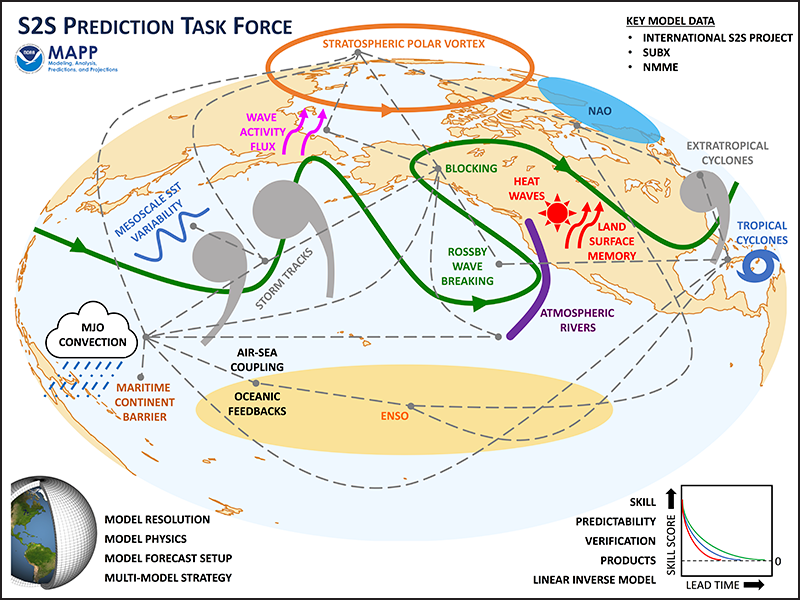For years, researchers have been working to tackle the subseasonal to seasonal (S2S; commonly defined as two to six weeks in advance) prediction problem to improve forecasts. Prediction during this timeframe is difficult because it falls between the prediction of weather, when particular storms are predictable up to 10 days in advance, and seasonal prediction, where general conditions but not specific storms are predictable and driven by slowly evolving conditions such as sea surface temperature or soil moisture. In order to tackle this issue, the Climate Program Office’s Modeling, Analysis, Predictions, and Projections (MAPP) Program launched two initiatives in 2016 to bring researchers from universities, labs, and centers together to collaboratively advance research and capabilities for S2S prediction.
One initiative was a Task Force, led by the community, to explore various aspects of the S2S prediction problem and especially to understand where predictability at those timescales comes from. The other initiative was called the Subseasonal Experiment, SubX, an interagency research-to-operations project led by Kathy Pegion, from the Department of Atmospheric, Oceanic, and Earth Sciences and the Center for Ocean-Land-Atmosphere Studies at George Mason University, and Ben Kirtman, from the University of Miami’s Rosenstiel School for Marine and Atmospheric Sciences. A paper describing the SubX effort and results was recently published in the Bulletin of the American Meteorological Society.

A diagram of some of the many natural processes that underpin weather predictions during the S2S timeframe, along with the modeling systems and products included in the S2S Task Force activities.
The SubX project focused on understanding and improving subseasonal prediction. To do this, the researchers used 7 global models to produce 17 years of forecasts of the past (or re-forecasts) and over a year of weekly real-time forecasts.
“To fully capture the range of phenomena and extreme and hazardous weather on the subseasonal timescale, more frequent initializations, or analyses of observed weather, were needed than was available in monthly and seasonal hindcast databases,” Pegion explained. “This project is unique because it makes three to four week forecasts available right now and provides researchers the data infrastructure to investigate how to make them even better in the future.”
With the combined seven models, the researchers found that the mean of the multimodel ensemble was more skillful than any individual model overall. They also found that the models show skill for temperature and precipitation three weeks in advance in specific regions, four weeks in advance for the Madden-Julian Oscillation (MJO) and two weeks in advance for the North Atlantic Oscillation (NAO).


SubX real-time multimodel ensemble mean anomaly and probability guidance for temperature (a,b) and precipitation (d,e) and official corresponding NOAA Climate Prediction Center week 3-4 outlook products for temperature (c) and precipitation (f).
“Better forecasts, better decisions,” said Pegion about how this research will support the public. “More skillful predictions on these timescales reduce risk and allow for better disaster preparedness related to extreme and hazardous weather.”
Along with better forecasts and information for the public, Pegion explained that SubX will also provide comprehensive research and real-time response to the subseasonal component of the Weather Act and NOAA can use the results for applications like marine ecosystems and coastal flooding. Additionally, there are many users in the research community, particularly within the MAPP S2S project, who are using SubX data to investigate diverse topics such as heat wave initiation and maintenance, tropical storm formation and precipitation, MJO and NAO predictability, air-sea interactions, model resolution impacts on forecast fidelity, and the sources and consequences of model biases.
The original SubX project, now complete, was recently reviewed and found to be an excellent model of research-to-operations. The project simultaneously integrates the research community into operational concerns, providing a useful operational capability to improve forecasts, thus bridging the typical divide between the operational centers and academic research communities. The report described the value provided by the project to the operational forecasters: “The SubX project has provided value to Climate Prediction Center operational outlooks at subseasonal time scales, contributing to the weekly forecast decision process, reducing the area of “equal chances” (where not enough information is available to make high or low forecasts) for temperature and precipitation in weeks 3 and 4, and contributing week-to-week stability to forecasts.”
While SubX is a large accomplishment in subseasonal to seasonal research, the researchers are already thinking of a second phase with plans to parse out the contributions of individual models and to produce forecasts further in the past and a large model ensemble. The project review noted the future potential of the SubX dataset: “Given that published peer-reviewed literature is the principal metric of scientific contribution, this has been a strong return on investment for CPO’s MAPP program, particularly as the SubX data set will continue to enable further research for years to come.”



